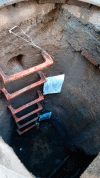Molecular detection of Leishmania infantum in rats and sand flies in the urban sewers of Barcelona, Spain
- PMID: 35710435
- PMCID: PMC9201797
- DOI: 10.1186/s13071-022-05309-4
Molecular detection of Leishmania infantum in rats and sand flies in the urban sewers of Barcelona, Spain
Abstract
Background: Classically, dogs have been considered to be the only reservoir of leishmaniasis in urban areas. However, in a previous study, we found a 33.3% prevalence of Leishmania infantum in the spleens of Norway rats (Rattus norvegicus) sampled in the underground sewer system of the city of Barcelona (Spain). The aim of the present study was to verify, using molecular methods, the potential reservoir role of these rats in the same sewer system.
Methods: A sensitive real-time PCR (qPCR) assay, DNA sequencing and phylogenetic analysis were carried out to identify and quantify the presence of L. infantum DNA in sand fly individuals captured in the same underground sewer system of Barcelona as in our previous study and in the spleens and ears of rats captured in the same sewer system.
Results: Leishmania infantum DNA was found in 14 of the 27 (51.9%) sand flies identified as Phlebotomus perniciosus, and 10 of the 24 (41.7%) rats studied were infected. Leishmania infantum was found in the spleens (70%) and in the ears (40%) of the infected rats. Quantitative results revealed the presence of high loads of L. infantum in the rats studied (> 3 × 106 parasites/g ear tissue) and among the sand flies (> 34 × 106 parasites in 1 individual).
Conclusions: The molecular methods used in this study demonstrated a high prevalence of L. infantum in the underground sewer populations of both R. norvegicus and P. perniciosus. These results suggest that sewer rats, in addition to dogs, are likely to act as reservoirs of leishmaniasis in cities, where sewer systems seem to offer the ideal scenario for the transmission of leishmaniasis. Therefore, to achieve the WHO 2030 target on the elimination of leishmaniasis as a public health problem successfully, an efficient control strategy against leishmaniasis in rats and sand flies should be implemented, particularly in the sewer systems of urban areas of endemic countries.
Keywords: Barcelona sewer system; Leishmania infantum; Phlebotomus perniciosus; Rattus norvegicus; Underground leishmaniasis.
© 2022. The Author(s).
Conflict of interest statement
The authors declare that they have no competing interests.
Figures
References
-
- WHO . Ending the neglect to attain the Sustainable Development Goals: a road map for neglected tropical diseases 2021–2030. Geneva: WHO; 2021.
MeSH terms
Substances
LinkOut - more resources
Full Text Sources
Medical


